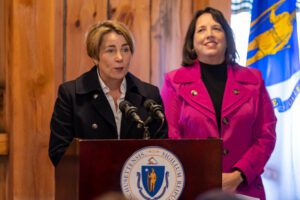Who is a member?
Our members are the local governments of Massachusetts and their elected and appointed leadership.

Gov. Maura Healey and Lt. Gov. Kim Driscoll announce the creation of a Director of Rural Affairs position during a visit to Williams Farm Sugarhouse in Deerfield on March 10. (Photo courtesy of Joshua Qualls/Governor’s Press Office)
Gov. Maura Healey and Lt. Gov. Kim Driscoll visited Franklin County on March 10 to announce the creation of a Director of Rural Affairs to ensure that the state’s rural communities are better represented in state government.
The director of rural affairs, within the Executive Office of Economic Development, will serve as a dedicated advocate and ombudsman for rural communities. The director will be responsible for cultivating rural economic development and coordinating with secretariats and state agencies to ensure that state government is attuned to the unique needs of rural communities.
“For the first time in state history, we will have a dedicated staff member committed to coordinating across state government to support economic development in rural communities,” Healey said during an appearance in Deerfield. “We want to send a clear message to every single person who calls rural Massachusetts home: We see you, we value you, and we’re going to work every day to ensure you have the representation and support you deserve.”
Driscoll said the new director “will bring the level of intentionality to our policy making that rural communities deserve.”
The director of rural affairs will be tasked with conducting a review of all state grant opportunities to ensure that barriers for rural and small towns are mitigated. The director will also host dedicated office hours for rural towns to provide technical assistance to identify and explore grant opportunities.
The administration is also committing to maintaining and updating the Community Compact Connector Calendar so that small municipalities can find all state grants in one place and better coordinate their application efforts.
“Our economy needs to work for everyone, including the 181 rural communities and small towns across our state,” said Housing and Economic Development Secretary Yvonne Hao. “Through this role, rural and small towns will have an advocate in state government committed to helping their economies thrive.”
With rural communities in mind, the governor noted that her fiscal 2024 state budget (H. 1) proposes:
• $25 million for Food Security Infrastructure Grants to aid farmers, fisherman, schools, nonprofits, and local producers and to construct infrastructure to bolster the local food system
• $7.5 million for rural school aid
• A $6.5 million (14%) increase for payments in lieu of taxes (PILOT) for state-owned land, and ensuring that all municipalities receive the same or higher payments
• A $2 million increase in the dairy tax credit cap, to $8 million, to protect dairy farmers from fluctuations in wholesale milk prices
• A nearly $9 million increase in base funding for regional transit authorities, and $19 million for new grant opportunities for transit providers, including RTAs, to enable providers to explore new service models
• A $570,000 increase in the Department of Agricultural Resources’ MassGrown and Fresher branding campaign, agricultural fairs, farmers markets, and agricultural education initiatives
• Funding for three new staff positions to bolster the Agricultural Preservation Restriction program, facilitating farmland acquisition and protection
• Expanded support for the Community One Stop for Growth with a $1 million investment into technical assistance to help municipalities identify ways to breathe life into underutilized parcels, and committing $600,000 for the Massachusetts Downtown Initiative to help further community development efforts in town centers and downtowns with planning support
The administration’s budget also proposes funding for the Massachusetts Department of Transportation to continue to explore next steps for West-East Passenger Rail. This includes $650,000 for five full-time employees, including the position of a West-East Rail director. The budget also recommends $12.5 million for components of a future West-East Rail, including track improvements at the Pittsfield Station and the study and design of Palmer Station.